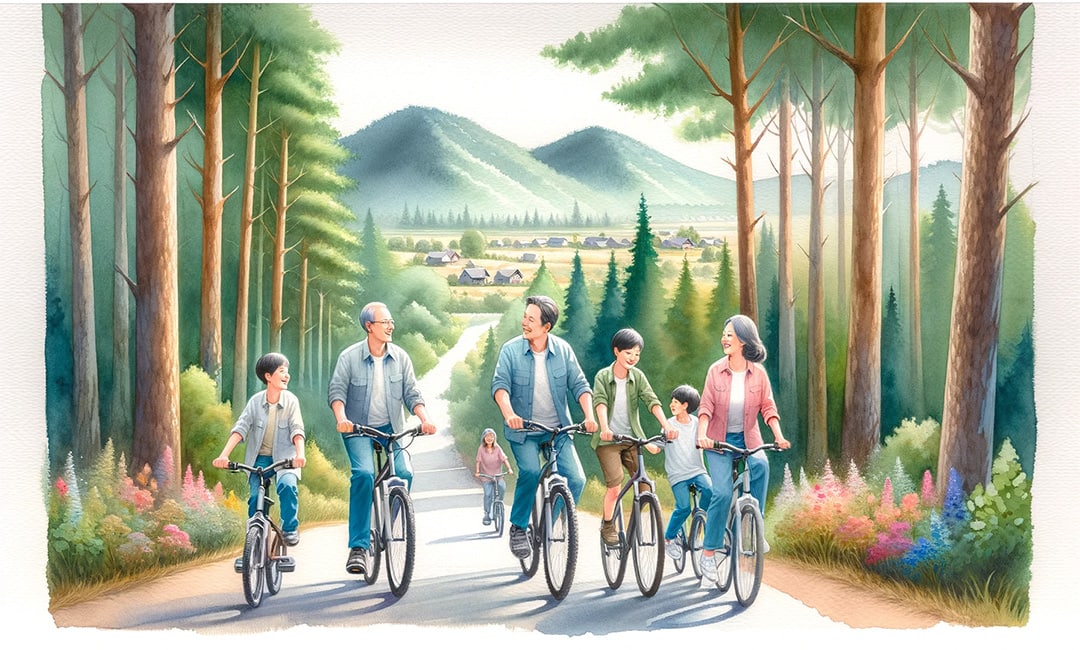


How to Handle Four Common Types of Team Conflict

Use Strategic Thinking to Create the Life You Want
Bardzo mi przykro, ale lekcje na platformie The Blue Tree działają jedynie na komputerze lub tablecie.
Do zobaczenia na większym ekranie 🙂
Zespół The Blue Tree
back to HOME > General Interest > Man and Society >
THE BLUE TREE
Man & Society

CEFR B2
Upper
Intermediate
warm up
Answer these questions. Listen to Sarah, a woman from the USA, answer these questions. Report back what you have heard.
| Do you think it is important to have and follow a strategy when you want to be successful in business? |
TRANSCRIPT
Absolutely, I believe having and following a strategy is crucial for success in business. In my experience, transitioning from science to finance, I’ve seen how a well-thought-out strategy can make a huge difference. Just like in science, where experiments need careful planning, in business, you need a clear plan to navigate through challenges and capitalize on opportunities. For me, blending my scientific background with business strategies has been really beneficial. It helps me approach problems analytically and make decisions based on data. So, yes, a good strategy is not just important, it’s essential for success in any business field.
| How do you define a good life? |
TRANSCRIPT
For me, a good life is all about balance and fulfillment. It’s about finding that sweet spot where my professional achievements and personal happiness coexist harmoniously. As someone who’s passionate about both science and business, I believe in setting goals in these areas and working towards them. But a good life isn’t just about work. It’s also about nurturing relationships, enjoying hobbies, and taking care of my health. It’s important to have time for family and friends and to do things that rejuvenate the soul, like reading a good book or spending time in nature. Ultimately, a good life is one where you feel content, challenged, and connected, both to your own goals and the people around you.
| Can you think of something that is significant for you, but you do not spend enough time on it? What is it? |
TRANSCRIPT
Yes, definitely. For me, that would be scientific research. Even though I’ve transitioned into finance, my love for science never faded. I miss being deeply involved in scientific studies and experiments. It’s something that always sparked joy and curiosity in me. But with a demanding career in finance, finding time for in-depth scientific research can be challenging. I try to stay updated and occasionally dabble in small projects, but I definitely wish I could dedicate more time to it. It’s a passion of mine that I hope to revisit more seriously in the future.
part one
key language
watch the video
COMPREHENSION
- ⌚ 0:09 What is the Strategize your Life course about?
- ⌚ 0:17 How many steps does the program have?
- ⌚ 0:26 How experienced is the speaker in the area of strategy?
- ⌚ 0:37 How did his background in science help him?
- ⌚0:44 What example illustrates this principle of applying an idea from one field to a different field?
- ⌚ 0:50 What question did he ask himself?
part two
key language
watch the video
COMPREHENSION
- ⌚ 1:02 What is a corporate strategy?
- ⌚ 1:27 What is the definition of a life strategy?
- ⌚ 2:35 What are the seven steps in business strategy?
- ⌚ 2:35 How do they translate into life strategy questions?
- ⌚ 2:47 How do many people define a great life?
- ⌚ 3:00 Why doesn’t earning more money increase our happiness?
- ⌚ 3:19 What did Prof. Martin Seligman created?
- ⌚ 4:09 What do the letters in PERMAV stand for?
part three
key language
watch the video
COMPREHENSION
- ⌚ 4:48 What are strategic life units? What can we invest in them?
- ⌚ 5:00 Who is your first strategic life unit (SLU)?
- ⌚ 5:29 What are the other 16 Strategic Life Units?
- ⌚ 5:59 What are the three pieces of information we need to collect about SLU?
- ⌚ 6:19 What is a Strategic Life Portfolio?
- ⌚ 6:32 What does the 2×2 matrix show?
- ⌚ 7:14 What did 95% of participants of their training have?
- ⌚ 7:26 What do many people put in the lower right square?
part four
key language
watch the video
COMPREHENSION
- ⌚ 7:54 What can we change in our portfolio?
- ⌚ 8:11 What do we find in the upper left corner?
- ⌚ 8:30 What advice does Michael give if we have an issue with relationships and friends?
- ⌚ 8:47 What do people who had an issue with social media did in the training?
- ⌚ 9:12 What is the right Portfolio?
- ⌚ 9:19 How will it look on the matrix?
part five
key language
watch the video
COMPREHENSION
- ⌚ 9:33 Can we really come up with a strategy for our lives?
- ⌚ 9:41 What do we need to know, even in uncertain times?
- ⌚ 9:49 What did Seneca say about not knowing where we are sailing?
- ⌚ 9:53 What two things do we need to be open to?
- ⌚ 10:12 What does the second Seneca’s quote mean as regards life strategy?
DISCUSSION
How do you define a great life?
Read a fragment from an article on “How to Strategize Your Life” from Harvard Business Review.
When the calendar page flips from one year to the next, most of us take some time to reflect on what we’d like to do differently in the 12 months ahead. Many people make New Year’s resolutions. Fewer stick to them.
Companies also use the close of their fiscal year to review performance and refine strategy, but they tend to do it in a much more methodical way. If they’re following best practices, they have a purpose or mission statement, a five – or 10 – year vision to guide them, tools to assess their portfolio of businesses and activities, and a suite of key performance indicators to track progress.
A few years ago, BCG consultants Rainer Strack, Susanne Dyrchs, and Allison Bailey began to wonder if this process could be adapted to help individuals think more clearly about their own personal and professional lives. They created a program called Strategize Your Life, which they’ve now tested with more than 500 people, from recent college graduates to retirees, first-time managers to CEOs.
(…)
Let’s get right to step one: How do you define a great life?
Any corporate strategy process starts with defining metrics for success. For instance, the organization might choose to focus on driving sales growth, maximizing profit, or having a positive impact on society.
What are the right metrics for you? Some might aim for money, fame, and power, but studies have shown that meaningful relationships are more important drivers of long-term happiness. Of course, each of us will have a different view on what combination of things are really important in life.
Strack, Dyrchs, and Bailey recommend using the PERMA model, introduced by Martin Seligman and later developed into PERMA-V, which stands for:
- Positive emotions, or frequent feelings of pleasure and contentment
- Engagement, or being in the flow of something and losing track of time
- Relationships, or mutual feelings of caring, support, and love
- Meaning, or contributing to making the world a better place
- Achievement, or striving for success or mastery
- Vitality, or being healthy and energetic
Rate how critical each of the above elements is to you on a scale from 0 (not important) to 10 (very important). You can also add your own categories, such as autonomy or spirituality. This quick assessment will give you a rough idea of how you define a great life.
PERMA-V SURVEY
Use the tool below to assess your PERMA-V factors.
What’s important to you?
Read a dialogue between Alita and Pete. They are discussing their scores in the PERMA-V survey.
Alita: Hey Pete, remember that “Strategize Your Life” session we had last week? I’ve been thinking a lot about those PERMA-V factors we talked about.
Pete: Oh, yeah, the survey was pretty eye-opening. I never really thought about breaking down my well-being into those specific areas. Positive emotions, engagement, relationships, meaning, accomplishment, and vitality, right?
Alita: Exactly! I scored pretty high on positive emotions and relationships but realized I’m lacking in the accomplishment department. How about you?
Pete: For me, it’s a bit of a mix. I feel quite engaged in what I do, especially at work, and I’ve got a good sense of vitality, probably thanks to my morning jogs. But, I’m with you on the accomplishment part. It’s like I’m doing things, but not necessarily the things that feel impactful, you know?
Alita: Totally get that. It’s like, we’re busy but are we moving in the direction we really want? I’m thinking of setting some clear goals for myself, kind of like what we do here at work with our performance indicators.
Pete: That’s a good idea. I should probably reflect more on what ‘meaning’ really means to me. Maybe start some projects that align more with my personal values.
Alita: Yeah, and I think keeping up with the vitality aspect is important too. You’re doing great with your jogging. I should probably pick up something like that. Maybe yoga or something.
Pete: Definitely. It’s all about balance, isn’t it? Making sure we’re not just focusing on one area. I think the survey helped highlight that. So, are you going to make any big changes?
Alita: I’m planning to, starting with some small steps. Maybe take up a new hobby and set some achievable career goals for the year. How about you?
Pete: Same here. I’m going to spend some time figuring out what really gives my life meaning and try to incorporate more of that. Maybe volunteer work or mentoring.
Alita: Sounds great, Pete. It’s good we’re taking these steps, isn’t it?
Pete: Absolutely. It’s like we’re fine-tuning our lives. Let’s catch up again soon to see how we’re both doing with these changes.
OVER TO YOU
Now, discuss these questions.
- What is your opinion on the Strategize Your Life program? Can it really work?
- How deliberate are you about your own life goals and plans?
- Do you agree that life is a chain of lucky events?
- What do you think of the PERMA-V factors? Are they complete?
- Which of the PERMA-V factors would you like to improve and why?
- Which of the factors are you the most satisfied today?
lesson glossary
Revise the vocabulary from this class using this glossary.

Write an Effective Self-Assessment
Bardzo mi przykro, ale lekcje na platformie The Blue Tree działają jedynie na komputerze lub tablecie.
Do zobaczenia na większym ekranie 🙂
Zespół The Blue Tree
THE BLUE TREE
Business English

CEFR B2
Upper
Intermediate
warm up
Answer the questions below. Then listen to Bella, a woman who works in the cunsulting industry, give her answers. Report back what you heard.
| How do you feel about yearly assessment meetings? |
TRANSCRIPT
I have mixed feelings about them, honestly. On one hand, they’re a great opportunity to reflect on the past year – looking at what I’ve achieved and where I can improve. It’s also a chance to set clear goals for the coming year. However, sometimes these meetings can feel a bit formulaic and don’t always capture the day-to-day realities of my job. I try to go into them with a positive attitude, though, because feedback is essential for growth, even if the process isn’t perfect.
| Do you keep track of your achievements over the year? Is this a good idea? |
TRANSCRIPT
Absolutely, I do keep track of my achievements throughout the year. I believe it’s a really good idea, especially in a field like auditing where the details matter a lot. Keeping a record helps me stay organized and ensures I don’t miss anything during my yearly assessment. It’s not just about listing what I’ve done, but also reflecting on how each achievement aligns with our company’s goals and values. This practice has made preparing for assessments much easier and more effective, and it also gives me a sense of accomplishment to see all that I’ve achieved over the year.
| If a colleague of yours felt really anxious about their meeting with the boss, what advice would you give them? |
TRANSCRIPT
If a colleague felt anxious about their meeting with the boss, I’d tell them, “First, remember that it’s completely normal to feel a bit nervous. These meetings are important, but they’re also an opportunity for growth. My advice would be to prepare well. Look over your achievements and think about how they’ve contributed to the team and the company. Also, be ready to discuss areas where you want to improve and perhaps have some ideas for future goals. It’s a two-way conversation, so feel free to ask for feedback and support. Lastly, stay positive and remember that your boss is there to help you succeed, not just critique you. You’ve got this!”
key language
Go through these words and expressions.
Check out if you know what they mean and how to pronounce them.
LISTENING
Listen to a presentation on the topic “How to Write an Effective Self-Assessment”.
What are the main points mentioned by the speaker?
reading
Read the text below.

Write an Effective Self-Assessment
Writing a self-assessment can feel like a box-checking exercise, but it sets the tone for your manager’s evaluation of your work. Follow these five steps to nail this critical part of your performance review.
Focus on the entire year. Don’t just default to your most recent accomplishments. If you didn’t keep notes, take a peek at your calendar to remind yourself of the projects you worked on and significant conversations you were a part of.
Consider broader company and functional goals. Identify the work you did that directly contributed to the big picture. Your goal is to tie your day-to-day work to your organization’s success.
Look for alignment with company values. How you approached your job is just as important as what you accomplished. Identify the behaviours and attitudes you brought to work that upheld your organization’s values and culture.
Seek feedback from colleagues. Reach out to your co-workers to understand their perception of you and your work. Ask: What do I do well? What have I improved on this year? And what do you hope I improve on in the year to come?
Draft a concise list of accomplishments. Pick no more than five of the most impactful achievements to highlight. Each one should have fulfilled an organizational goal, advanced the company’s values and culture, and been informed by feedback from colleagues.
This tip is adapted from “How to Write an Effective Self-Assessment,” by Marlo Lyons
Comprehension
Answer the questions below using the information from the presentation and the article.
- What is the first step suggested in the article?
- Why is it important not to focus only on recent accomplishments?
- In the second step, what is emphasized as crucial when reflecting on your work?
- According to the third step, what should you reflect on in your self-assessment?
- Step four involves feedback from colleagues. What are the three key questions you should ask them?
- What is the recommended number of significant achievements to include in your self-assessment?
PRACTICE
PERFORMANCE REVIEW
Bella had a performance review with her boss, Mr Norton. Read their dialogue.
How do they incorporate ideas from this lesson?
Mr. Norton: Bella, thank you for joining me. I’ve been looking forward to discussing your performance this year.
Bella: Thank you, Mr. Norton. I’ve prepared for this meeting and I’m eager to hear your feedback.
Mr. Norton: Well, let’s start with your overall contributions. I’ve noticed your work this year aligns well with our broader company goals. Can you share your perspective on this?
Bella: Absolutely. I’ve tried to ensure my audits are not just thorough but also contribute to our firm’s objectives. For instance, the efficiency improvements in the XYZ project directly supported our goal to enhance client satisfaction.
Mr. Norton: That’s a good example. How about the company values? How do you feel you’ve aligned your work with those?
Bella: I believe in leading by example, so I’ve embraced our values of integrity and diligence in every project. I’ve also encouraged my team to uphold these standards, fostering a culture of excellence and ethical practice.
Mr. Norton: I’ve noticed that, and it’s commendable. Tell me about the feedback you received from your colleagues.
Bella: I reached out to several team members. They appreciated my detail-oriented approach and my willingness to mentor new auditors. They did suggest, however, that I could enhance my delegation skills to manage workload more effectively.
Mr. Norton: That’s constructive feedback. Now, let’s talk about your key achievements this year.
Bella: I’ve narrowed it down to five major accomplishments. For instance, the successful audit of our largest client not only met but exceeded the compliance standards, which was a significant win for us.
Mr. Norton: Indeed, that was a highlight for our team this year. Bella, it’s clear you’ve done an outstanding job. Your self-awareness and dedication to professional growth are impressive. You’ve set a high bar, not just for yourself but for your colleagues as well.
Bella: Thank you, Mr. Norton. I appreciate your feedback and look forward to continuing to contribute to our team’s success.
Mr. Norton: Absolutely. Let’s keep this momentum going into the next year. Keep opening those doors to self-awareness and development, Bella.
Bella: Will do, Mr. Norton. Thank you for this constructive review.
Over to You
Write your own self-assessment using the tips from this lesson.
COMMENTS
Share your views and experience here.

Hot 21 – make or do
Bardzo mi przykro, ale lekcje na platformie The Blue Tree działają jedynie na komputerze lub tablecie.
Do zobaczenia na większym ekranie 🙂
Zespół The Blue Tree
THE BLUE TREE
Tests & Quizzes

CEFR B1
Intermediate
TEST YOUR ENGLISH

One of the most common mistakes that learners struggle with is related to collocations with the verbs “make” and “do”.
Complete these 21 examples with “make” or “do”.
Remember to write the correct grammatical form of these verbs.
You need at least 15 correct answers to receive a beautiful certificate 🙂










COMMENTS
Share your comments here.